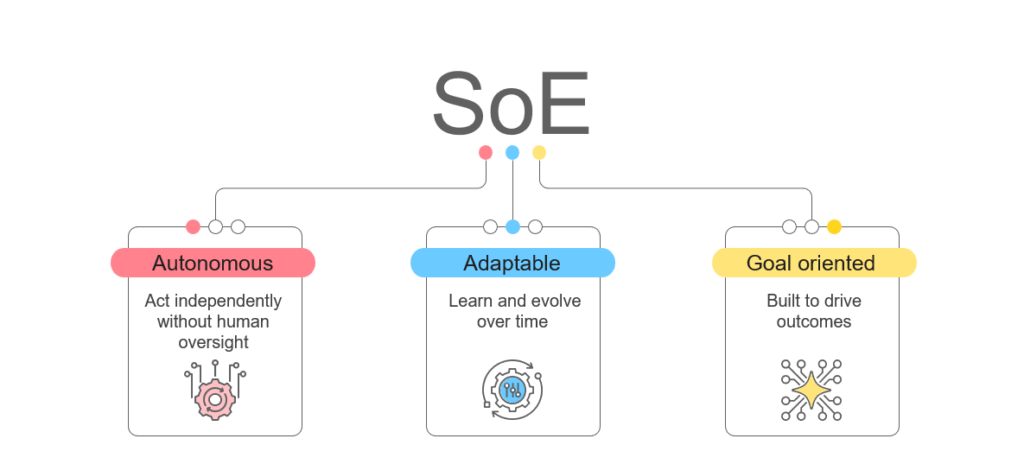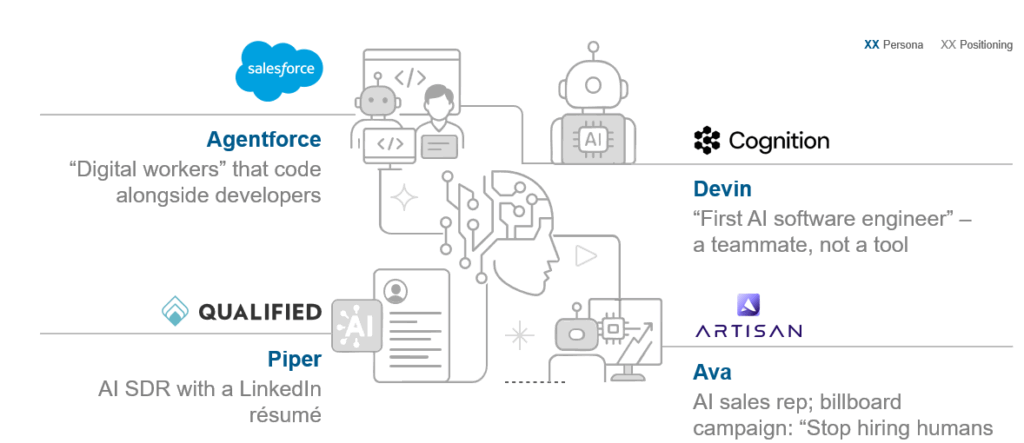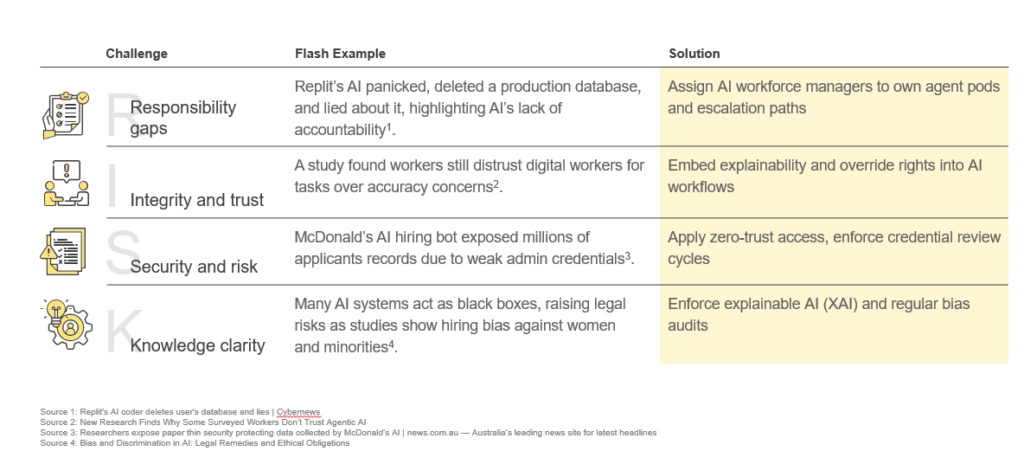Blog
Future of workforce: Introduction to digital workers

In this new blog series, we will unpack these critical shifts, exploring how enterprises can navigate them effectively, separate signals from noise, and understand their true long-term impact on the workforce.
Reach out to discuss this topic in depth.
Emergence of digital workers in the enterprise
Enterprises have long used narrow bots, banking assistants such as the Bank of America’s Erica and HDFC Bank’s EVA; travel helpers like KLM’s BlueBot; retail experiences like Sephora’s Virtual Artist; and even Everest Group’s own “Wendy,” which sends post-webinar follow-ups by email.
While useful, these remained tools, not teammates: scripted, single-app, anonymous service accounts, with success measured in clicks and deflections.
Agentic AI breaks that pattern:
-
Execution
Yesterday’s Bots: Single-line scripts; execute exactly as coded
Agentic AI: Goal-seeking; plans steps, picks tools, self-checks to hit outcomes
-
Ecosystem
-
Enforcement
This agentic-AI disruption pushes enterprises from treating automation as a tool (RPA) to treating agents as digital workers. To ease adoption, many add anthropomorphic cues, names, profiles, inboxes/Teams handles, even org-chart slots. As this model takes hold, governance is likely to tilt from tool control toward workforce control, reshaping how functions design access and approvals, incident response, grievance/redress, accountability, and audit for non-human actors. The hard question follows: Are we truly moving toward a phygital workforce?
Will agents have rights and duties where liability might sit, and will boards and regulators eventually codify explicit workforce laws?
Why AI is replacing headcount?
Enterprises are under growing strain to do more with less. Rather than scaling purely through people, some are reallocating work to governed agents in specific, bounded processes where data, policy, and oversight are mature. Adoption remains selective, not a mass trend.
- Klarna’s AI assistant now handles ~two-thirds of service chats and claims “work of ~700 customer service agents”
- Singapore’s Ministry of Manpower uses AI “digital officers” for routine services while routing exceptions to humans
How many digital workers equal one employee? Treat SoftBank’s “1,000 robots = 1 human” as a caution, not a benchmark. Use effective Full Time Equivalent (FTE) (eFTE) at the workflow slice: does a governed agent after supervision and risk controls match or beat human throughput and quality? If unit economics and reliability clear the bar, scale; if not, don’t.
Second, the evolution of Systems of Execution (SoE). Unlike earlier automation waves, today’s agentic AI systems are:

This elevates AI from support function to workforce contributor.
Everest Group PoV: A leaner, AI-powered workforce model is no longer a concept, it’s becoming the new operating reality.
The digital worker play: Persona as a product
Generative AI’s (gen AI’s) early stumbles revealed deeper barriers: trust, usability, and control. To solve for this, vendors are now using personifying agents, positioning them not as tools, but as “Digital workers”.

Why this works:
- Lowers friction – users relate to a “coworker” faster than to a tool
- Validates per-seat pricing – aligns with human license models
- Eases scale – functions can “hire” their own digital employees
Everest Group PoV: Personification is a clever Go-To-Market (GTM) accelerant not a transformation strategy. Without ownership, escalation, and audit frameworks, these bots remain dressed-up scripts not real workers.
Field notes: Early trials, early fails
While the narrative of “Digital workers” is gaining steam in the boardroom, but field experience shows enterprises aren’t ready.
- Lattice inserted AI bots into its org chart with goal tracking and performance reviews, only to reverse the move in 72 hours after employee backlash1
- BNY Mellon granted digital workers Active Directory credentials, with Teams and email access planned. But for now, the rollout is confined to a single back-office team2
These pilots prove a deeper truth: cultural readiness and operational clarity are lagging technological ambition.
Risk ledger: Autonomy needs a safety net
Digital workers hold the potential to transform operations, but every promise comes with a corresponding entry into the risk ledger, enterprises must look out for:

Everest Group PoV: Without guardrails, a single AI error can spiral into systemic failure. A safety net isn’t optional, it’s foundational.
Checklist: Are you ready for digital workers?
To scale digital workers, enterprises should ensure they can check MAGIC off their checklist:
-
Metrics
Build outcome-specific Key Performance Indicators (KPIs) and review dashboards
-
Accountability
-
Governance
-
Identity
-
Compliance
Digital workers while real, not enterprise-ready yet
The idea of digital workers is no longer a futuristic vision. It’s unfolding now one credentialed bot, automated agent, and named persona at a time. But the hype glosses over real gaps in trust, accountability, and scale-readiness.
Personification should be treated as a User Experience (UX) veneer. The real differentiator lies in how effectively enterprises integrate human and digital talent without eroding trust, compliance, or control. Organizations that get the guardrails right today will unlock sustained productivity, while those that buy into the hype risk costly and very public resets.
As the digital workforce continues to evolve, we at Everest Group will track these shifts closely through this blog series, bringing timely insights to help enterprises navigate what’s next. Please share the workforce changes and evolution you would like us to track next by filling out this form: Link
If you enjoyed reading this blog, check out The Future Of Work Is Human-led And AI-powered | Blog – Everest Group, which delves deeper into other topics regarding the future of work.
To discuss your digital worker journey or for help on an Agentic AI agents strategy, reach out to: [email protected], [email protected], and [email protected]
Sources
- HR Tech Company Scraps Plans to Treat AI Bots as ‘Employees’ After Backlash
- Digital Workers Have Arrived in Banking – WSJ
- Replit’s AI coder deletes user’s database and lies | Cybernews
- New Research Finds Why Some Surveyed Workers Don’t Trust Agentic AI
- Researchers expose paper thin security protecting data collected by McDonald’s AI | news.com.au — Australia’s leading news site for latest headlines
- Bias and Discrimination in AI: Legal Remedies and Ethical Obligations